This post may contain affiliate links. As an affiliate, I may earn a small commission if you make a purchase through these links—at no extra cost to you. I only recommend items I personally trust or believe can genuinely support therapists in their professional practice.
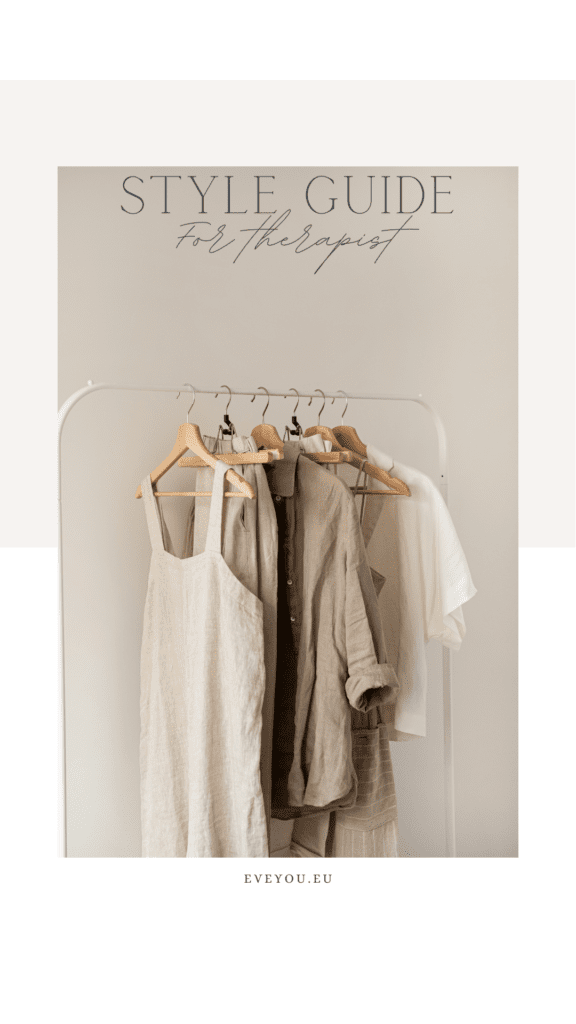
As a school counselor and content creator, I’ve learned that what we wear in the therapy room can have a powerful effect—not just on our confidence, but also on how clients perceive us. The right outfit can create a sense of trust, calm, and professionalism, while still allowing you to move freely and feel like yourself.
In this style guide, you’ll find professional outfit ideas specifically curated for therapists, counselors, and psychologists who want to feel both polished and comfortable. From classic staples to expressive touches, this guide is your go-to wardrobe inspiration for therapy work in any setting.
Each outfit idea is paired with real-life examples and styled images to help you create your own confident, comfortable work wardrobe—so you can focus on what really matters: holding space for others.
In this guide, you’ll learn:
- Why therapist attire matters: how strategic clothing choices bolster client comfort and your professional image.
- Wardrobe essentials: the timeless staples every therapist needs for a polished look.
- Outfit categories: proven ensembles for business-professional, smart-casual, virtual sessions and seasonal weather.
- Styling hacks: expert tips on fit, color, layering and accessories.
- Affiliate picks: curated links so you can similar pieces featured and build your ideal wardrobe effortlessly.
Comfortable Yet Professional Wardrobe Staples for Therapists
Therapists spend long hours sitting, listening, moving between sessions, and sometimes engaging in activities that require more flexibility—like working with children or facilitating groups. That’s why comfort isn’t just a luxury—it’s essential to staying grounded, focused, and present with your clients throughout the day.
But comfort doesn’t have to mean looking casual or underdressed. With the right materials and silhouettes, you can create a polished appearance that also supports your physical well-being.
Therapist-Approved Fabrics That Move With You:
- Stretch cotton: Offers breathability and structure, perfect for warm days or layered under blazers.
- Soft knit blends: Think elevated loungewear—pull-on trousers, midi skirts, and wrap tops made from rayon or jersey knit.
- Lightweight ponte or modal fabric: Holds its shape while offering more give than traditional office wear.
- Unstructured blazers in soft fabrics: These offer professionalism without the stiffness of tailored suits, and they pair beautifully with both dresses and slacks.
💬 Personal tip:
“On days when I have back-to-back sessions, I rely on a soft pair of wide-leg knit trousers and a breathable blouse layered under a relaxed-fit cardigan. It keeps me comfortable and looking composed, even during long stretches without a break.”
Style Balance: Comfort Meets Professional Presence
- Look for pants with elastic or hidden stretch waistbands that still offer a tailored silhouette.
- Choose midi skirts or shirt dresses that allow movement while maintaining coverage.
- Avoid overly tight or rigid materials, which can cause discomfort during long seated sessions and may distract from your ability to stay present.
Comfort-first outfits allow you to move with ease, regulate your own nervous system, and model calm confidence—something your clients will notice
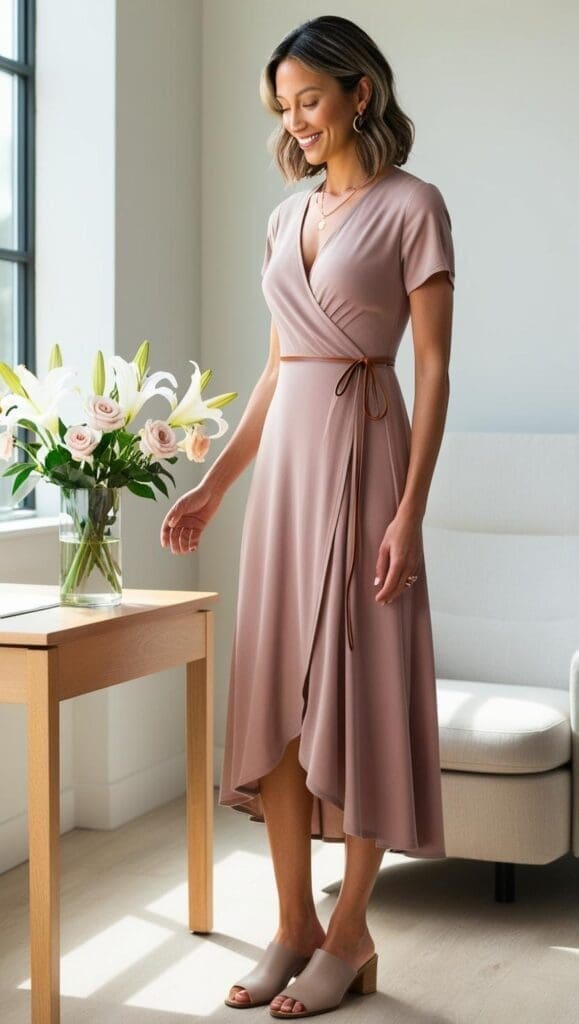
Key Takeaway: Invest in a concise capsule of high-quality basics—blazers, tailored pants, knit tops—that mix-and-match for endless professional looks.
Timeless Pieces for a Classic Look
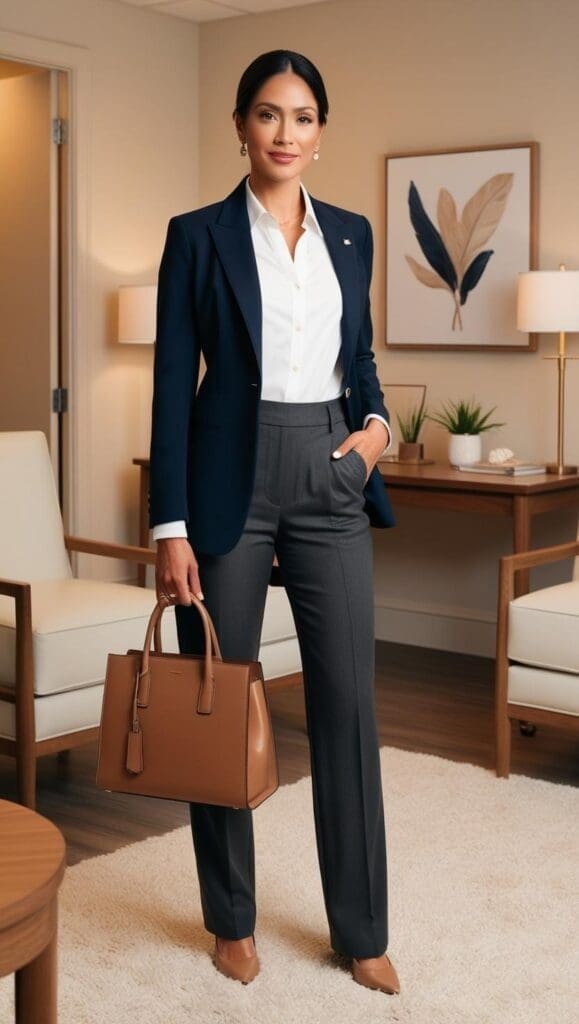
A structured blazer, crisp button-down and well-fitted trousers form the core of any professional wardrobe. Look for:
- Blazers in neutral hues (navy, charcoal, black) with a slight stretch for comfort.
- ** trousers or pencil skirts** that sit at your natural waist for a flattering silhouette.
- Silk-blend or cotton shirts in white, light blue or soft pastels for effortless polish.
👉 Shop these tailored blazers
👉 Browse classic trousers
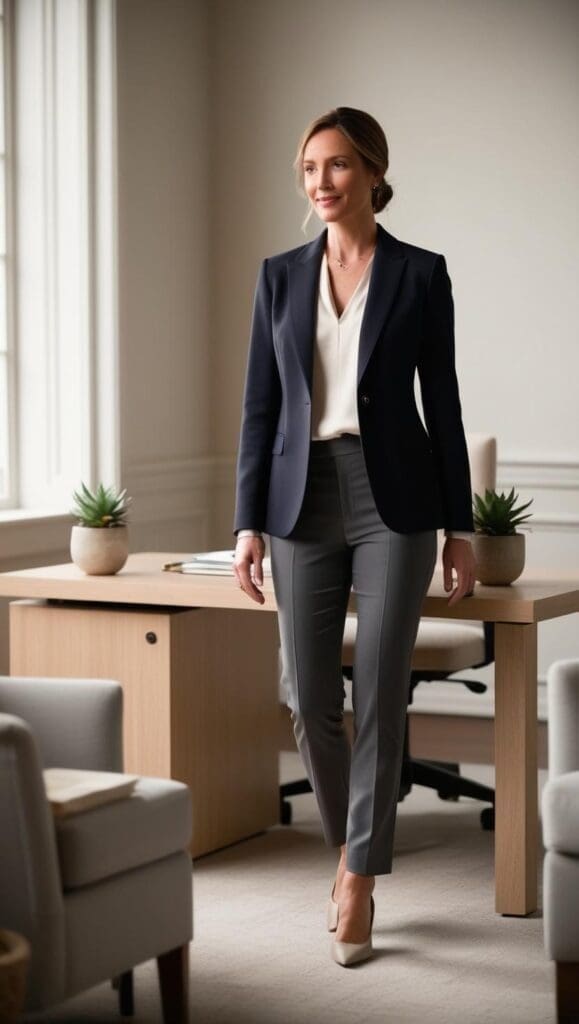
Comfort is Key
Therapy sessions often span back-to-back—choose fabrics and cuts that let you move freely:
- Stretch blends (2–5% elastane) in trousers and skirts.
- Soft knits or lightweight sweaters for breathable warmth.
- Supportive flats or low block heels that cushion each step.
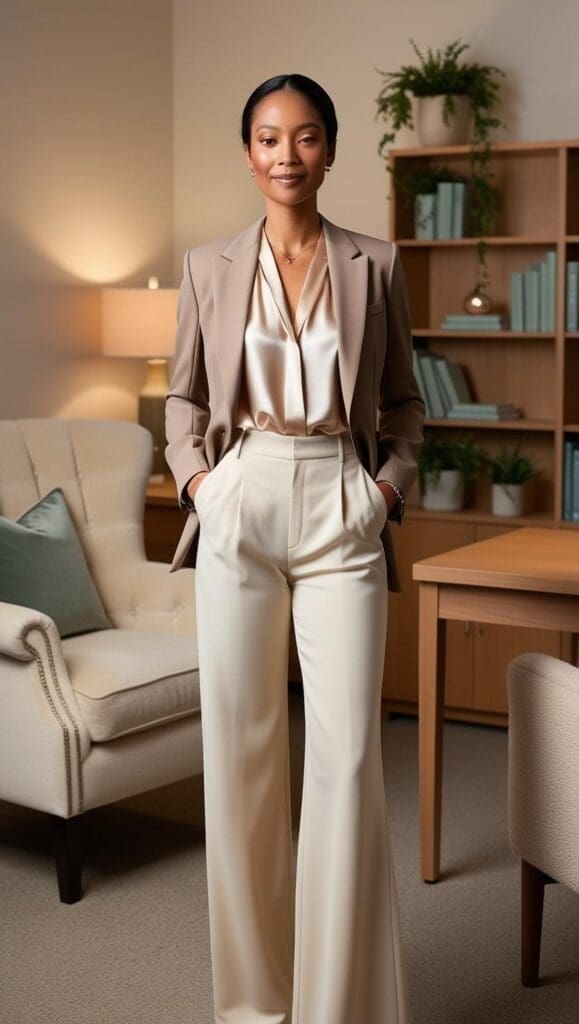
How to Add Personality Without Breaking Professional Boundaries
As therapists, our clothing is more than just a style choice—it subtly communicates tone, approachability, and professionalism. While many therapy settings lean toward neutral or conservative attire, that doesn’t mean your wardrobe has to feel bland or impersonal.
The key is to add thoughtful touches that reflect your style while still keeping the therapeutic space client-centered and calming.
Ways to Add Personality (the Subtle Way):
- Scarves: A patterned or textured scarf can elevate a plain blouse or dress while adding warmth and softness to your appearance.
- Statement jewelry (kept simple): Think small gemstone necklaces, meaningful pendants, or minimalist earrings that reflect your personality without being flashy.
- Color pops in footwear or cardigans: A pair of burgundy flats or a dusty rose wrap adds interest without dominating your look.
- Muted patterns: Choose soft florals, tone-on-tone stripes, or small-scale prints that feel expressive but not loud.
- Cultural or symbolic accessories: Consider small pieces that are meaningful to your identity (e.g., a woven bracelet, heirloom ring) as conversation starters or grounding items.
💬 Therapist insight:
“Too much boldness can be overwhelming, especially for anxious or sensitive clients. I’ve found that grounding tones like sage green, dusty blue, and muted gold offer personality without distraction.”
What to Avoid:
- Bright neon colors or high-contrast prints that might overstimulate the senses.
- Overly trendy items that shift focus away from the therapeutic work.
- Noisy or oversized accessories that can draw attention or become a sensory trigger.
Adding subtle touches of personality through accessories, color, and texture allows you to show up authentically while still keeping the therapeutic space client-focused.
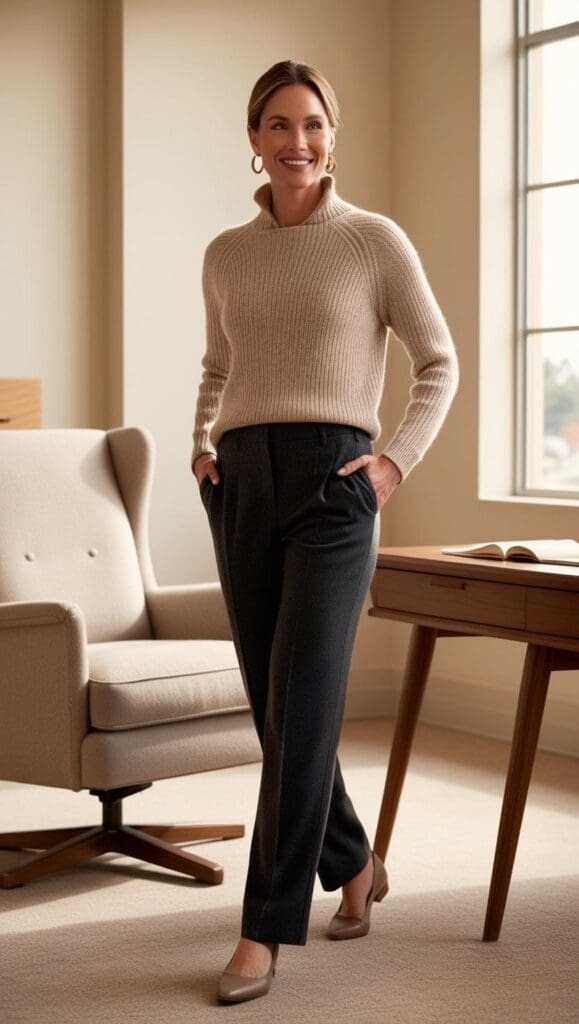

Therapist Outfit Ideas for Clinical or Hospital Settings
In clinical or hospital-based settings, therapist attire often needs to align with a more medical or administrative dress code—especially when working alongside nurses, physicians, or support staff. That doesn’t mean sacrificing style or comfort, but it does mean leaning into functional, polished, and easy-care pieces that project professionalism and respect for the environment.
What to Prioritize in Clinical Settings:
- Easy-wash, wrinkle-resistant fabrics: Choose materials that hold up during busy shifts and can be easily cleaned—especially important if you work in high-contact roles.
- Closed-toe flats or low-profile shoes: Safety comes first in shared healthcare environments. Look for cushioned, washable shoes in neutral tones like taupe, navy, or black.
- ID lanyards or subtle name tags: Essential for hospital environments and easy to match with your wardrobe if you choose muted or soft-tone accessories.
- Monochrome layering: Wearing soft neutrals—like light grey, beige, soft blue, or slate green—creates a calming visual impression and allows for seamless mix-and-match combinations.
💬 Styling tip:
“Pair soft jogger-style pants with a structured cardigan and a tucked-in blouse. It strikes the perfect balance between approachability and tidiness—and you can move comfortably through a full schedule.”
Outfit Ideas That Work in These Settings:
- Soft tapered pants with a tucked blouse and stretch blazer.
- Midi-length knit dresses layered under a long cardigan with pockets.
- Breathable button-ups with elastic-waist trousers and slip-on loafers.
- Scrub-adjacent pieces in neutral tones for hybrid roles in mental health clinics.
Pro tip for hospital-based therapists:
Keep a neutral-toned light jacket or longline vest on hand for temperature fluctuations between units. This layering piece can elevate your outfit while staying practical.
You can read more about clinical settings and outfit ideas Therapist Outfit Guide by Setting: What to Wear in Schools, Clinics, and More
Telehealth Therapist Outfits – Comfortable & Camera-Friendly
When working virtually, your presence is still deeply felt—even through a screen. In teletherapy sessions, what you wear from the waist up plays a big role in creating a professional, calming, and focused environment for your clients. The key is to find pieces that look polished on camera while still offering the all-day comfort you need when working from home.
What to Wear on Camera:
- Soft knit tops with structure: Look for boatneck sweaters, lightweight mock turtlenecks, or wrap-style tops that hold their shape and flatter on video.
- Blouses with detail near the face: A simple pleated neckline, button accents, or subtle collar frames your face and avoids looking flat on screen.
- Neutral and earth-toned cardigans or blazers: These layer easily and give a finished look while keeping your outfit warm and comfortable.
💬 Personal note:
“For video sessions, I always go for a top with a little structure—nothing too slouchy or too bright. I stick to muted tones like sage or dusty mauve, which help keep the screen calm and focused.”
Avoid on Video:
- Busy patterns (stripes or tiny prints can cause visual distortion).
- All-black or all-white outfits (they can wash you out or create harsh lighting contrast).
- Hoodies, large logos, or super casual T-shirts—even at home, professional presence matters.
Don’t Forget the Background
What’s behind you is part of your visual presence too. Use your clothing to complement your telehealth space:
- If your wall is light-colored, choose mid-tone clothing (like deep green or rust).
- If your background includes calming decor, mirror those tones in your outfit for a cohesive, grounded feel.
🖼️ Pro tip: Want to upgrade your telehealth space? Check out Minimalist Therapy Office Decor for subtle, stylish ideas that look great on camera and in real life.

Outfit Ideas for Therapists
With the right outfit, you can convey your professionalism while still expressing your personal style. Here are some outfit ideas for therapists that strike the perfect balance:
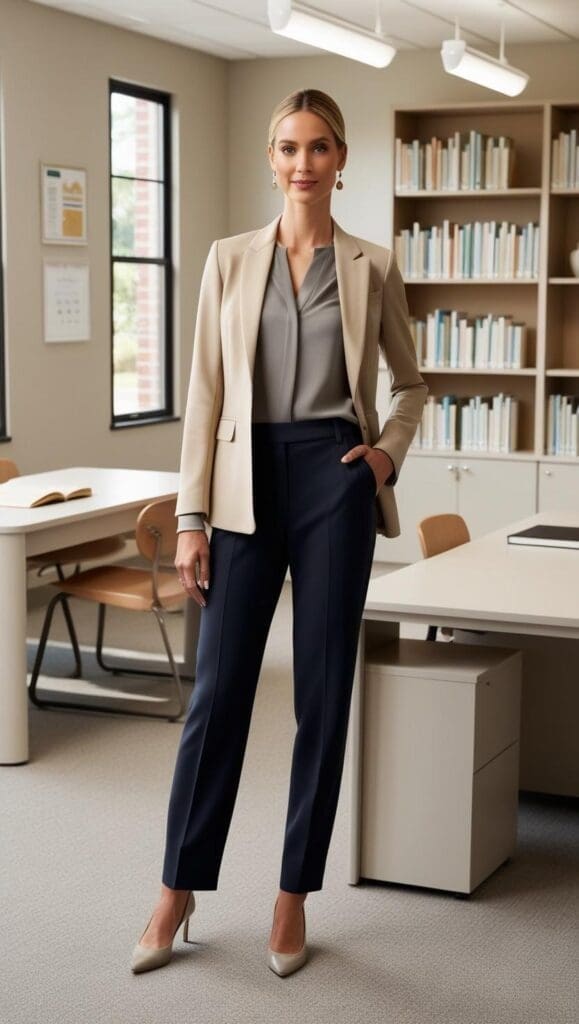
- Classic and Timeless: A well-tailored blazer paired with tailored pants or a skirt can create a polished look. Choose neutral colors like navy, black, or gray for a timeless and professional aesthetic.
- Smart Casual: For a relaxed yet professional vibe, pair a button-down shirt with tailored trousers or dark-wash jeans. Add a blazer or a cardigan for a more put-together look.
- Feminine and Elegant: Dresses or skirts in flattering cuts and lengths can exude femininity while maintaining professionalism. Consider incorporating soft prints or solid colors to showcase your personal style.
- Accessories: Complete your outfit with minimalistic accessories such as a statement necklace or a classic watch. Remember, simplicity and tastefulness are key in maintaining a professional appearance.
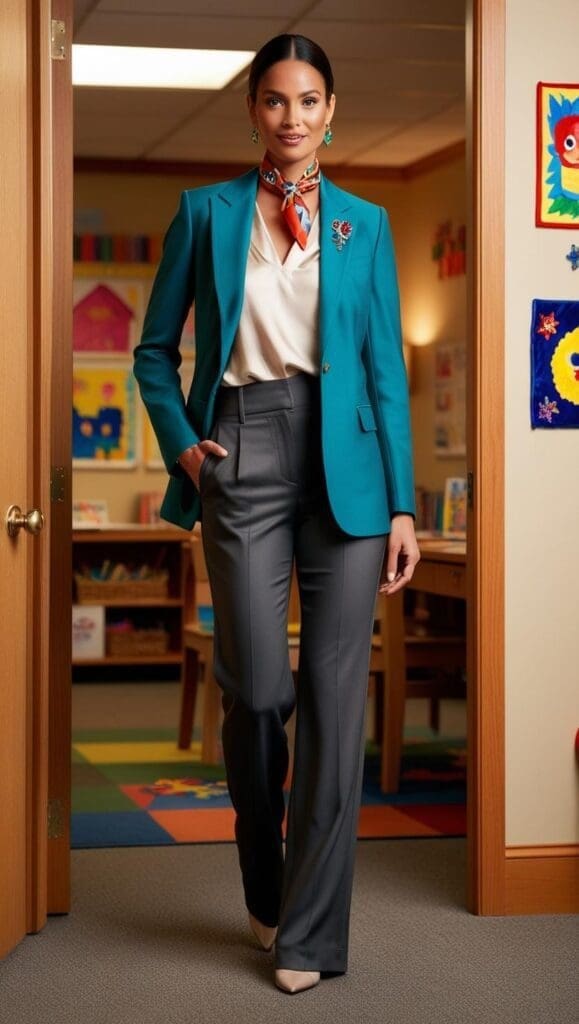
Remember, your professional attire should always be clean, well-fitted, and free from any distracting elements. Building a versatile wardrobe with staple pieces that can be mixed and matched will ensure you have options for different therapy sessions.
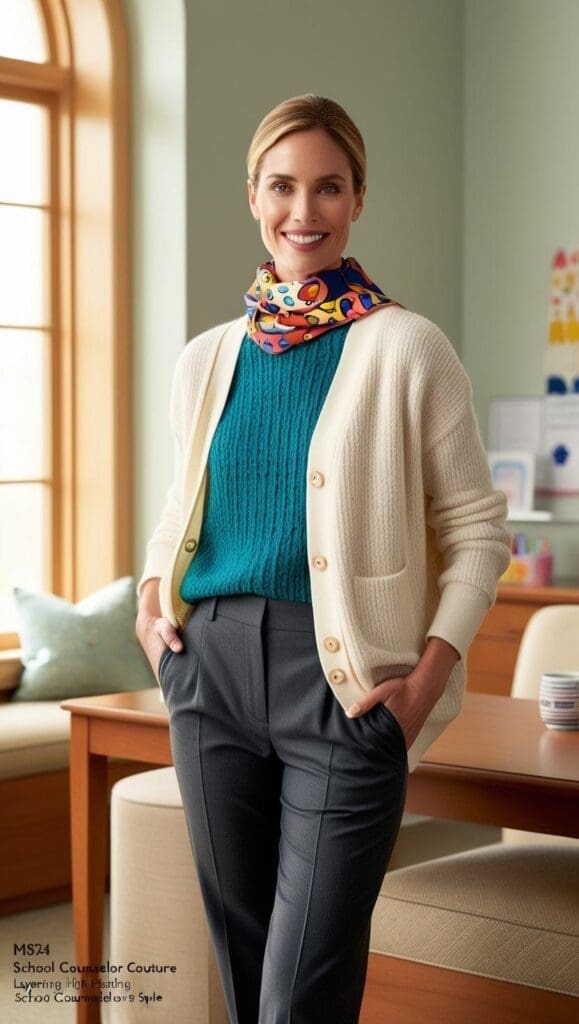
By dressing professionally and thoughtfully, you demonstrate respect for your clients and create an environment that fosters trust and comfort. Your attire can set the tone for the therapy session and contribute to creating a positive therapeutic space. Use the provided outfit ideas and fashion inspiration to curate a wardrobe that will elevate your therapist fashion game and boost your confidence.
Hungry for more targeted style advice? Check out these deep-dive guides:
- Refine your professional look with How to Dress Like a Professional Psychologist (Without Losing Comfort or Style)
- Master flattering silhouettes in The A-Line Advantage: How to Wear A-Line Dresses Professionally
- Refresh your spring wardrobe via 10 Stylish Therapist Outfit Ideas for Spring
- Stay cool & polished with Stylish and Professional Summer Outfit Ideas for Women Therapists
- Dress for action using our Camp Counselor Packing Guide
Styling Tips for Therapists
As a therapist, it’s important to project professionalism and create a comfortable setting for your clients. But that doesn’t mean you have to sacrifice personal style. Here are some practical styling tips to help you strike the perfect balance:
1. Choose the Right Colors
Colors can have a significant impact on the therapeutic environment. Stick to calming and neutral tones, such as blues, greens, and earthy neutrals, as they promote a sense of tranquility and relaxation. Avoid harsh or overly vibrant colors that could distract or overwhelm your clients.
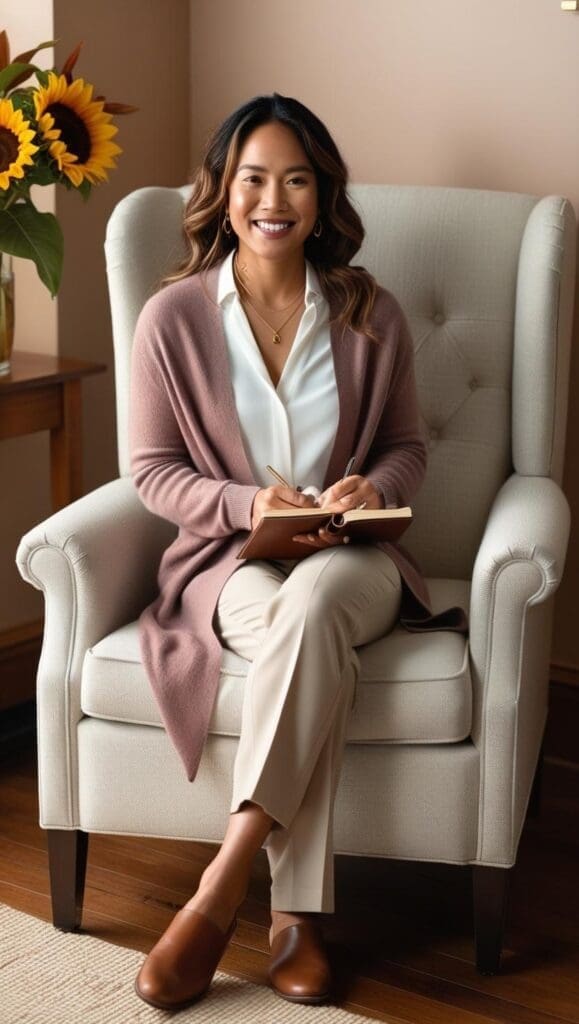
2. Opt for Comfortable Fabrics
Therapy sessions can be emotionally demanding, so it’s crucial to feel at ease in your clothing. Choose fabrics that are soft, breathable, and stretchy, allowing you to move freely. Natural materials like cotton or linen can offer both comfort and a polished look.
3. Consider Layering
Layering is a great way to add depth and versatility to your outfits. It allows for easy adjustment to changes in temperature while maintaining a professional appearance. Pair a lightweight cardigan or blazer over your base ensemble for a sophisticated touch.
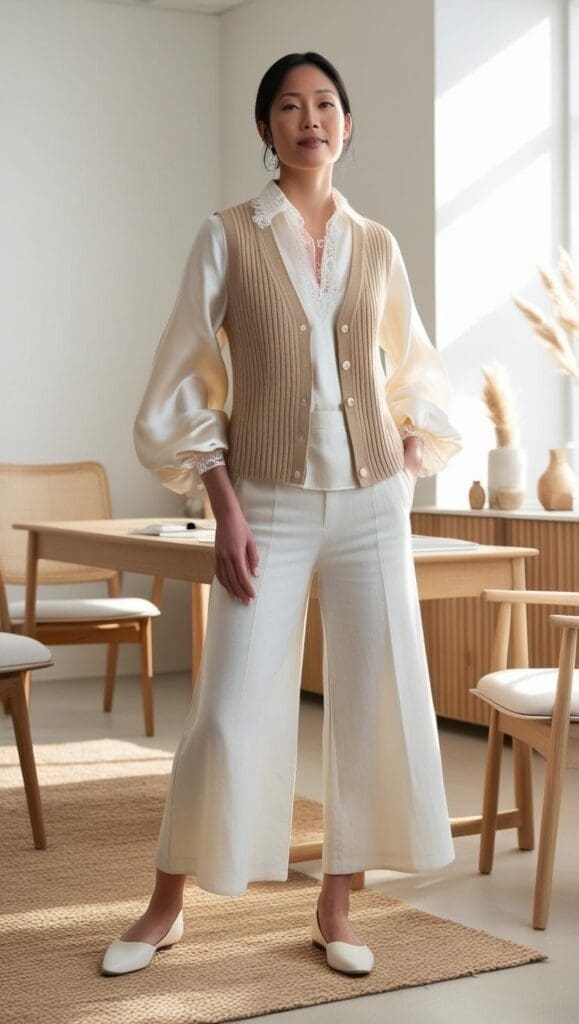
4. Express Your Personal Style
While maintaining professionalism, don’t be afraid to infuse your personal style into your outfits. Accessories like scarves, statement jewelry, or a well-chosen tie can add personality and individuality to your look. Just ensure they are not too distracting or overpowering.
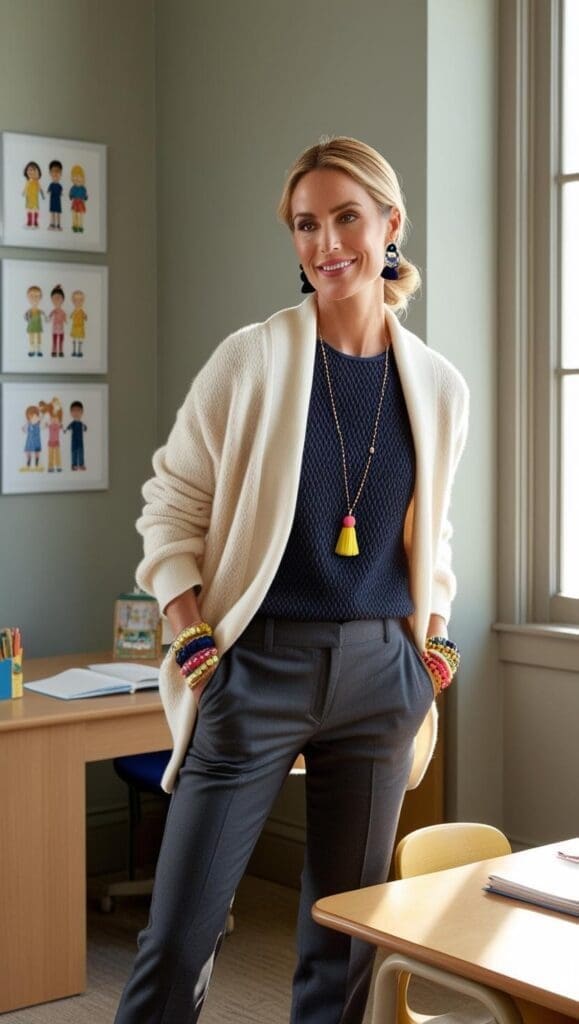
5. Pay Attention to Fit
Ill-fitting clothing can create discomfort and impact how you feel throughout the day. Opt for well-tailored pieces that flatter your body shape. Avoid overly tight or baggy clothes, as they may distract both you and your clients from the therapeutic process.
- Invest in a few key items that can be mixed and matched to create multiple outfits.
- Keep your clothing clean, ironed, and free of wrinkles for a polished appearance.
- Don’t forget about footwear. Choose comfortable shoes that are appropriate for your work environment.
- Remember that confidence is key. When you feel good in what you’re wearing, it’s easier to focus on your clients and provide effective therapy.
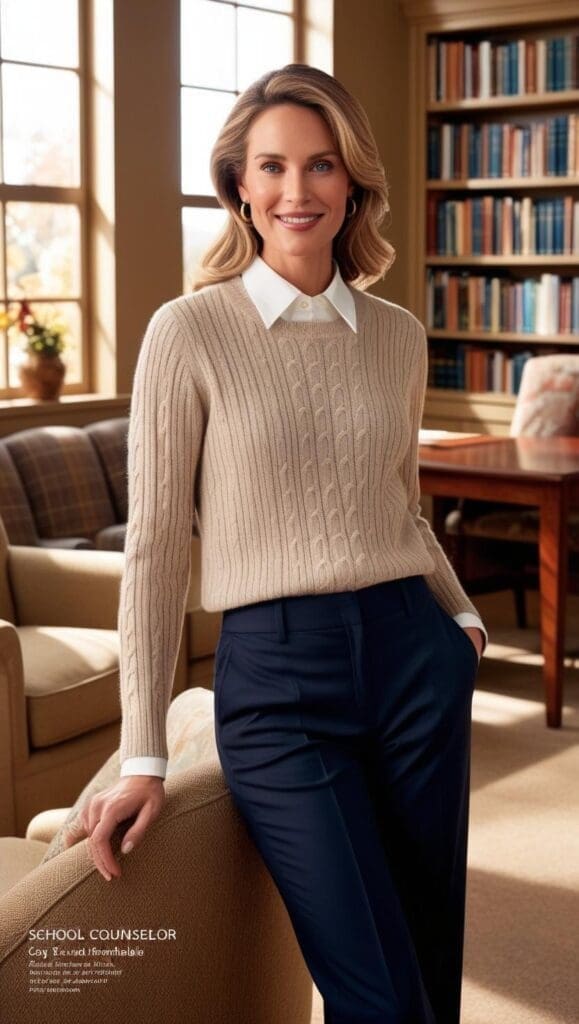
By following these styling tips, you can create a professional and stylish wardrobe that enhances your therapy sessions. Remember, the way you present yourself can contribute to building trust and rapport with your clients. Embrace your personal style, prioritize comfort, and allow your professionalism to shine through.
Final Thoughts – Dress the Way You Want to Show Up
Investing time and effort into curating a professional and stylish wardrobe can have a positive impact on your therapy sessions. When you dress appropriately and comfortably, you create an environment of trust and professionalism that allows your clients to feel at ease. By implementing the outfit ideas and fashion inspiration provided in this style guide, you can elevate your therapist fashion game and enhance the therapeutic relationship.
Remember, your attire is not just about personal style, but also about how it reflects your professionalism and commitment to your clients. Dressing in a manner that exudes confidence and respect sets the tone for productive therapy sessions. Whether you opt for timeless pieces or incorporate trendy elements, finding the right balance between comfort and professionalism is key.
Take the opportunity to experiment with different colors, accessories, and textures to add a touch of personality to your therapist wardrobe. Just ensure that your choices are appropriate for the therapeutic setting and align with your clients’ expectations. By creating a polished and confident look, you project an image that inspires trust and fosters a positive therapeutic environment.
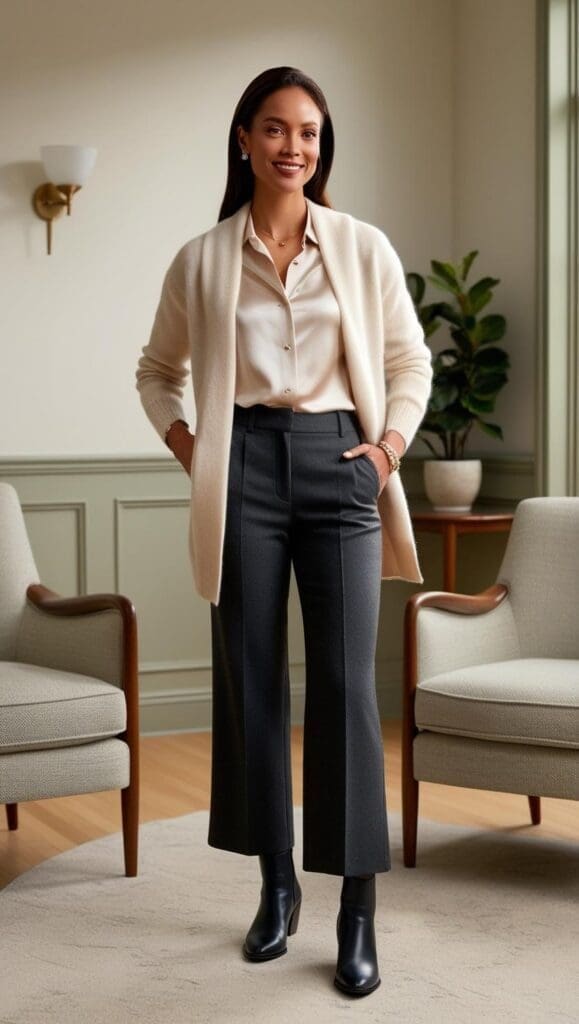
Dress with Confidence, Show Up with Presence
Your presence as a therapist starts the moment you enter the room—and your outfit plays a quiet but powerful role in that. Whether you’re drawn to minimalist neutrals, cozy layers, or a pop of color that reflects your personality, what you wear can help you feel grounded, confident, and ready to hold space for others.
Remember: professional doesn’t have to mean boring, and comfort doesn’t have to mean casual. With the right pieces, you can design a wardrobe that supports your day-to-day work while still expressing who you are.
Looking for more inspiration to elevate your therapy practice? Explore these next:
- How Therapist Clothing Affects Client Perception
- A-Line Dresses for Therapists – Elegant, Comfortable, Professional
- Therapist Outfit Guide by Setting: What to Wear in Schools, Clinics, and More
- Dark Aesthetic Office Decor Ideas for a Grounded Workspace
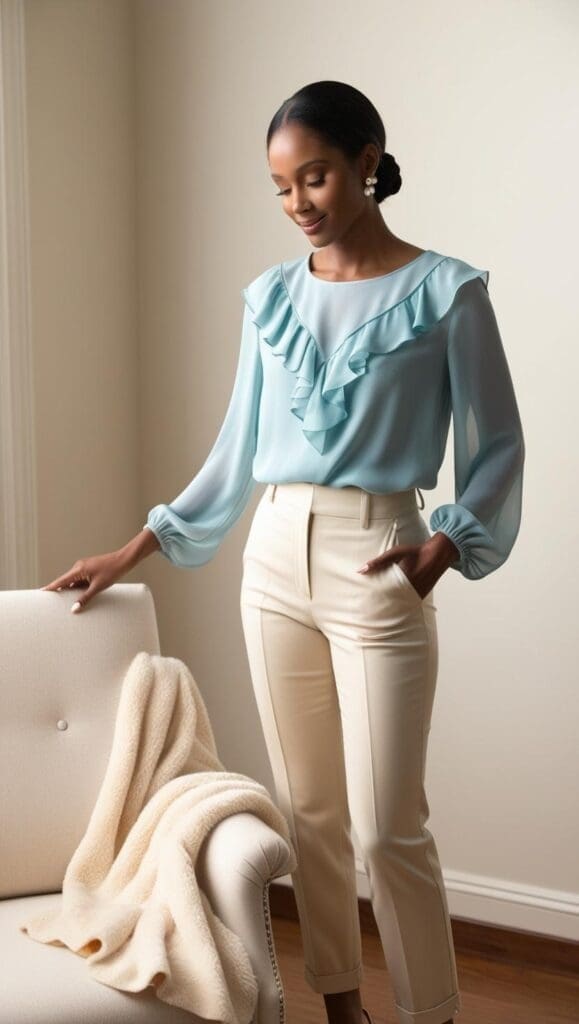
FAQ
Are there any specific outfit ideas for therapists?
Yes, there are plenty of outfit ideas for therapists that combine professionalism and comfort. You can opt for tailored pants or skirts paired with stylish blouses or shirts. Blazers or cardigans are also great options for layering. Accessorize with minimalistic jewelry and comfortable yet polished shoes.
Where can I find therapist fashion inspiration?
You can find therapist fashion inspiration from various sources. Browse fashion magazines, follow style influencers on social media, or visit online fashion platforms dedicated to professional attire. Additionally, you can join fashion forums or groups to connect with other therapists and exchange style ideas.
What are the essential wardrobe items for therapists?
Some essential wardrobe items for therapists include versatile pieces such as tailored pants, blouses, blazers, and dresses. Opt for neutral colors like black, navy, gray, and white, as they are classic and timeless. In addition, invest in comfortable shoes that are suitable for long hours of standing or walking.
How can I dress professionally for therapy sessions?
Dressing professionally for therapy sessions involves choosing outfits that are polished, comfortable, and appropriate for the therapeutic setting. Make sure your clothes are clean, ironed, and well-fitting. Avoid overly revealing or casual attire, and opt for a style that instills trust and confidence in your clients.
Can I incorporate my personal style into my therapist wardrobe?
Yes, you can definitely incorporate your personal style into your therapist wardrobe. Adding touches of color, patterns, or unique accessories can showcase your individuality while still maintaining a professional appearance. However, it’s important to strike a balance between personal style and maintaining a therapeutic environment.
How can I make my therapy outfits stylish without compromising professionalism?
To make your therapy outfits stylish without compromising professionalism, focus on choosing well-fitting and high-quality clothing. Pay attention to details such as tailoring, fabric quality, and accessories. Experiment with different textures, patterns, or statement pieces to add a dash of personality to your overall look.

About the Author
Hi, I’m Eve, a former school counselor with a master’s degree in School Psychology and a passionate advocate for children and families navigating sensory challenges. As a mom of children with sensory sensitivities, I deeply understand the journey special-needs parents face, and I dedicate myself to researching and sharing practical solutions to help children thrive and feel comfortable in their bodies. My goal is also to empower counselors, therapists, and psychologists with creative strategies and supportive resources to enrich their everyday practice. When I’m not writing or exploring new therapeutic approaches, you’ll find me spending quality time with my family and continually seeking inspiration from everyday moments.

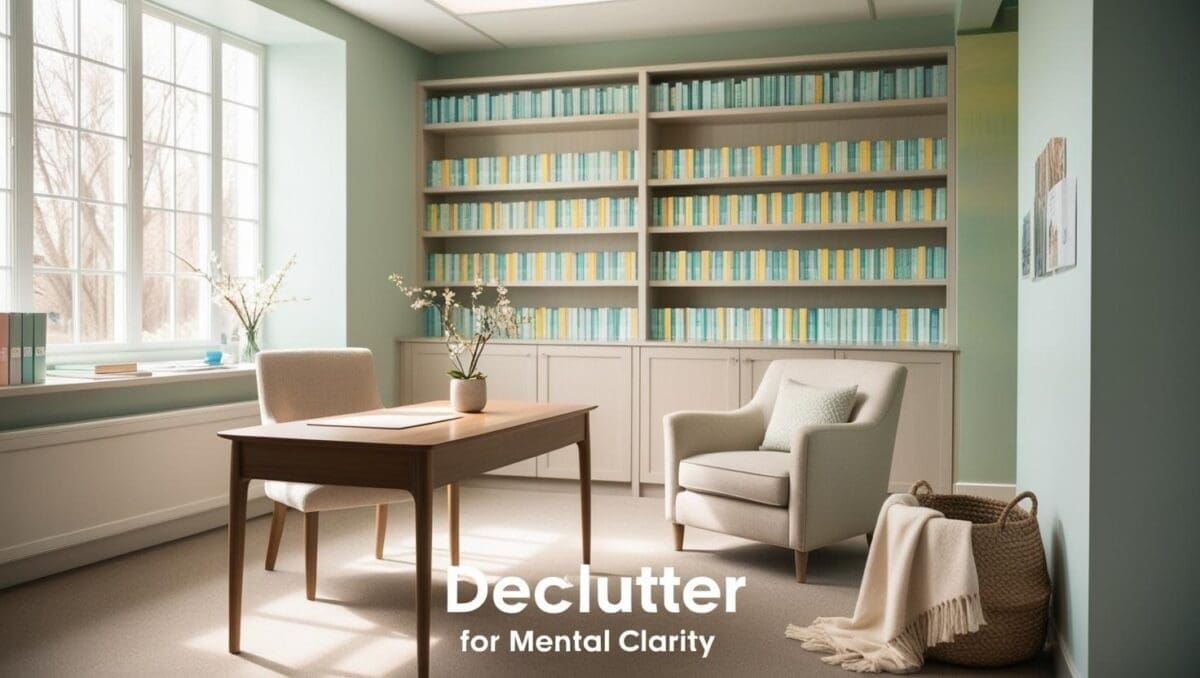

Pingback: The Ultimate Style Guide for Mental Health Professionals: Fashion Tips for Every Setting – EveYou
Pingback: Psychologist Outfit Guide: Professional, Comfortable & Stylish
Pingback: A-Line Dresses for Therapists: Professional & Feminine
Pingback: Spring Outfits for Therapists: 10 Elegant, Comfy Looks